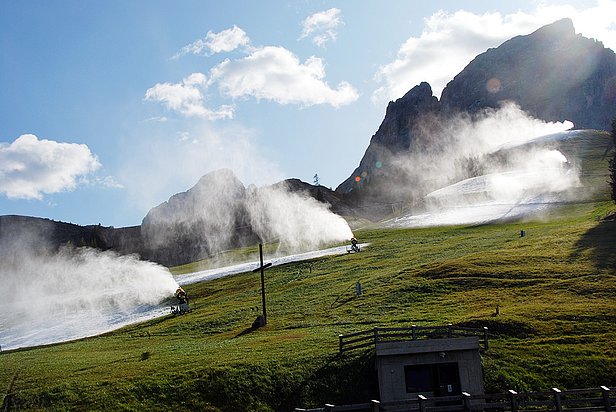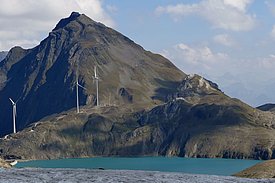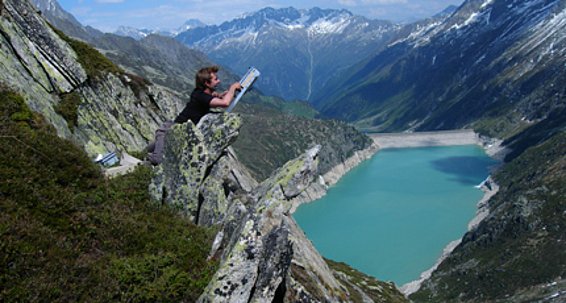In order to redesign Switzerland's energy economy the federal government intends to move mountains. Is it therefore time to launch a dynamic rush towards the Alpine summits?
Contents ¶
According to the federal government's energy strategy, the amount of electricity generated by hydropower is foreseen to rise by almost 10 percent in the period to 2050. The harnessing of wind energy requires erecting more than a thousend wind turbines, ideally in aspects exposed to maximum wind, namely in the Alps. The most suitable places for developing the country's photovoltaic resources are the sunny locations which stand out above the blankets of fog even in wintertime – once again: in the mountains. Finally, the mountains also sustain large quantities of energy-wood that could be used to a greater extent to produce electricity, heat and/or fuels. As a mountainous country, Switzerland is evidently very well equipped to overcome the challenges presented by the shift from nuclear and fossil fuels to renewables.
The shift towards renewables has consequences ¶
The Swiss energy economy cannot be remodelled without leaving a mark on both the environment and society in general. It makes sense, therefore, to look ahead. Within the framework of the research programme Energy Change Impact, initiated in conjunction with the Swiss Federal Institute of Aquatic Science and Technology (Eawag), the WSL and SLF are investigating both the necessary quantities of the resources required for the shift to renewables, such as water, sunshine, wind and biomass, and the potential impact of new or modified demands on their use. The projects outlined below are examples of the relevant work being performed in this connection.
How much water for hydropower? ¶
Despite its wealth of water resources, Switzerland is affected by shortages from time to time. Reservoir levels govern the amount of electricity that is generated. In order to estimate more accurately future water resources in the drainage basins that feed hydropower stations, researchers engaged in the Swiss Competence Center for Energy Research – Supply of Electricity (SCCER-SoE) are combining medium and long-term weather outlooks with snow melt forecasts. The goal is to enable hydropower plant operators to optimise electricity production while generating a profit. The relevant decision-making aids are based on extended-range forecasts (HEPS4Power) and decade-spanning forecasts covering periods up to ten years. All the models developed by the researchers are designed for alpine regions.
Conflict between electricity and snowmaking ¶
Hydropower stations are not the only major consumers of water resources. To an ever-increasing extent, water in the Alps is used for snowmaking – at precisely the time of year when reservoir levels are low. The SLF is examining the use of energy and water resources in winter sports regions with the aim of conserving the supply and avoiding conflicts of use by promoting appropriate day-to-day resource management in ski resorts.

Aggradation – a topic for the future ¶
As it releases formerly frozen rock and stone, climate warming is an energy-related conflict that is escalating. Mountain streams carry this solid material to the reservoirs, where it is deposited and contributes to silting or aggradation. A new bedload measuring station installed by the WSL on the Albula river in Tiefencastel is recording when and how much sediment reaches the Solis reservoir. By taking these measurements into consideration, the reservoir operator can optimise the timing of flushing operations to remove sediment. In addition, a sediment bypass tunnel can prevent excessive aggradation in the reservoir.
Hydropower and the human factor ¶
Plans to develop hydropower stations are often contested because of the serious implications for biodiversity and the landscape. Such resistance brings about delays and, in many cases, high costs. Researchers at the WSL are exploring how hydropower plant approval procedures could be facilitated or even accelerated through appropriate public consultation. Alongside this work, scholars at Eawag are investigating the willingness of Swiss citizens to pay for the maintenance of ecosystem services in connection with development plans. They are also seeking to identify the causal factors of society’s acceptance or rejection.
Mountains and energy security ¶
The Alps harbour not only untapped electricity-generating potential, but also natural hazards. Major infrastructure projects must be designed to withstand avalanches, landslides, storms and flood events. Researchers at the SLF and EPFL are examining suitable models for Switzerland's future energy system. Consideration is being given to several factors, including the existing infrastructure, favourable production sites, and the options available for storing energy.


